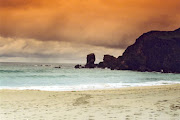Years ago,a friend of ours.Donald Alex.Maclean who was the local Church of Scotland minister at Carloway suggested that I contact Bishop Conti,then at Aberdeen for help with my enquiries.He told me that in the larger central libraries of Scotland(in the Reference Section) there were a series of volumes giving details of every ecclesiastical building ever built in Scotland. AND THERE IT WAS. "Dalmore Church.Rectangular in shape and 60 feet long". No dates,no attributions. Still,one piece of written evidence.We know from my grandad where the church was positioned.It started where our hen house was and ran at right angles to the top end of the house("the room") along the line of the hen run,as far as a grassy knoll called the "Creagan".This was not a particularly large church,but it was in existence long before the churches were built in the large township of Carloway.Without any evidence per se,I think the Dalmore Church came into being around 1820,attached to the Church of Scotland,during the time when the Earl of Seaforth owned the "Long Island"of Lewis and Harris.Now the Church has never sought ownership of the wee church in the Dailean,and the reasons may speak for themselves later in this narrative.They never had their own minister in Dalmore,but "borrowed" the minister from Keose in the parish of Lochs, on the other side of the island. A group of men would be sent to fetch the reverend gentleman.who was carried piggy-back by the men in turn across 12 miles of bog.You could not say that they were slack in their devotions.I believe woshippers in Carloway attended church in Lochs at this time, rather than cross the hill to Dalmore.They might have had there reasons for this!
In the year of the first British Census in 1841,there were 96 persons and 23 dwellings in Dalmore.That's a lot of people in one small glen. Dalmore strangely had a bad name,a place to visit only in necessity. Women, it was said,did not live very long in Dalmore. To be born illegitimately here was common,but a source of shame in any other village.The young man "responsible" was ordered to go away across the moor as far as he could,and there cut the largest "turf" he could carry, all the way back to Dalmore, and place it on the roof of the church as penance,and to help maintain the "fabric of the church" (thatch had not arrived yet).The roof is said to have fallen in a few times due to the inordinate quantities of turf placed thereon.
After the church service on a Sunday,it was common to see people selling whisky and tobacco to the villagers. Bad? This was as as bad as it gets,except for what was going on at the Creagan.Here we had young men arm wrestling and betting on the outcome.This was not the Calvinism that John Knox had preached and things would have to change.
Dalmore Daytime

Sandy Beach
Tuesday, 1 January 2008
Subscribe to:
Post Comments (Atom)


No comments:
Post a Comment